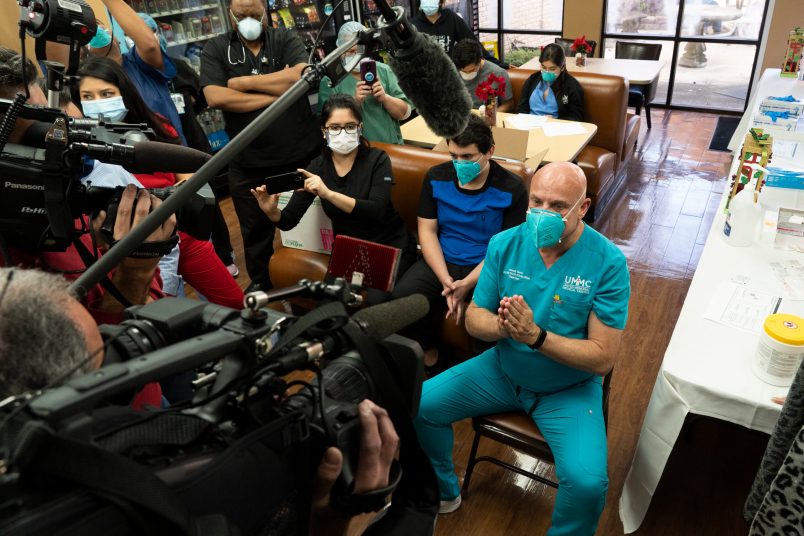As newly-cleared COVID-19 vaccines reach hospitals around the country, health care leaders tasked with divvying up the shots among staff are all answering the same question at the same time: Who goes first?
It’s a daunting balancing act, forcing administrators to weigh frontline workers with daily exposure to COVID-19 patients against the disease’s heavy mortality among older people and those with pre-existing conditions.
The first flare-up in the debate came Friday, when doctors at Stanford Medical Center protested an algorithm’s determination that just a handful of residents would be among those receiving the institution’s first 5,000 shots. “First in the room — back of the line!” they chanted in the hospital’s halls.
Stanford Medicine subsequently apologized and said it was revising its plan, but Stanford is hardly alone: A day prior, a marketing staffer set off anger among doctors at Mount Sinai, in New York, after posting a photo of himself receiving a vaccine. A spokesperson for the hospital system said that was a mistake.
“These fights within these institutions are basically about, if you will, who’s an essential worker,” said Arthur Caplan, a professor of Bioethics at NYU Langone.
“You’re defining it as risk for an essential workforce — keep the system going, serve the food, make sure you prevent the health system from falling apart.”
Not just exposure, but levels of exposure
Janis Orlowski, chief health care officer at the Association of American Medical Colleges, told TPM that hospital administrators she’d spoken to were generally vaccinating based on degrees of COVID-19 exposure.
“Not just ‘exposure’ but ‘greater exposure,’” she said. “So, the emergency room is being done before people who may see COVID cases, but not as much.”
This generally means prioritizing areas in which COVID-19 is most persistently present, like intensive care units. Personnel who regularly come in close contact with COVID-19 patients, such as those performing intubations, are also at risk.
There are secondary concerns as well, such as the common but relatively minor reactions to the vaccination like fever and fatigue, which could affect staffing levels if much or all of a given department gets vaccinated on the same day.
In Colorado, UCHealth sent its first invitations for vaccinations “to those with the most frequent and direct contact with patients who have COVID-19,” spokesperson Dan Weaver told TPM. After that, they sent randomized messages “to everyone else who works in clinical locations and who may have contact with patients who have COVID-19.”
In some systems, exposure levels aren’t the only factor. Rather, administrators are considering the relative risk the employee would face were they to get infected, on top of the likelihood that a given employee will be infected due to the nature of their work.
Washington University in St. Louis, for example, sorted by age among all “patient-facing” staff, starting with those aged 50 and older. “Patient-facing” is defined broadly, as “employees who work directly with patients or in patient care areas,” and without preference for those with the most potential exposure to COVID-19.
The university’s health network has said the schema reflects the greater risk older staff face if they’re infected.
“We want to protect, first, those at high risk of poor outcomes if they become infected,” said Hillary Babcock, medical director of occupational health (infectious disease) for Barnes-Jewish Hospital and St. Louis Children’s Hospitals, two university affiliates, in a Dec. 9 webcast on the policy.
‘A first-come first-serve scramble’
But even after risk is assigned, the tricky logistics of vaccine delivery have tripped up administrators and in some cases, stacked the deck against those in the trenches.
Mass General Brigham, the Massachusetts system, apologized to staff in recent days after its vaccine allocation app crashed — the result of a sign-up rush after the portal opened and thousands of people attempted to sign up for shots at once.
“A first-come first-serve scramble for vaccination appointments explicitly disadvantages people who work more,” one internal medicine resident, Emily Moin, tweeted of the scramble last week. “I’m about to start my night shift and I know that a hell of a lot of people who were vaccinated today are not going to work tonight or tomorrow or the next day. I don’t want to see your selfies.”
Once the system came back online, 10 minutes passed before all available slots were booked again. WGBH noted that the timeline disadvantaged night shift workers and those who were actively working at the time, without easy access to their cell phones or the internet.
Yolonda Wilson, a professor of bioethics at St. Louis University, told TPM that institutional decision-making on vaccine distribution and other tough questions can be biased by “who’s in the room” when a course is set — most often physicians and hospital administrators, and likely not janitorial staff or cafeteria workers.
“What ends up happening is, you have to rely on who’s in the room to be thoughtful,” Wilson said.
She framed the hospital vaccination debate as a precursor to the next several months of public rationing.
“What is this going to look like writ large?” Wilson asked. “We’ve seen health care systems struggling with these questions, and some of the major health care systems — that presumably have bioethicists on board — are fumbling.”



